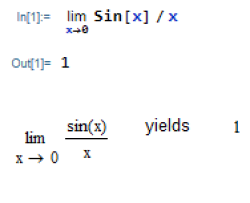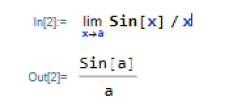by Joy Christian » Thu Apr 07, 2022 1:19 am
gill1109 wrote: ↑Wed Apr 06, 2022 11:41 pm
FrediFizzx wrote: ↑Tue Mar 29, 2022 3:23 am
gill1109 wrote: ↑Mon Mar 28, 2022 10:57 pm ...
Interesting. What do Mathematica and MathCad have to say about "lim_{x to 0} sin(x) / x"?


That is just the cursor bar at the end of that last x.
.
OK. Now substitute a = 0. You get 0/0.
I'm trying to get across to Fred that taking a limit by mere substitution does not always give the right answer.
Fred doesn't know the mathematical (epsilon-delta) definition of limit. Mathematica knows lots of things, but it manipulates symbols. The definition of limit depends on the topologies of the spaces you are working with. If you are not careful it will do formula manipulations which might be correct in the discrete topology but not correct in the usual topology of the real numbers.
Richard D. Gill, don't patronize Fred. Fred knows very well what "the mathematical (epsilon-delta) definition of limit" is. Unlike you Richard D. Gill, Fred has gone through the calculus course in high school. You, on the other hand, wrongly call yourself a "mathematician", which you are not. In fact, it is quite clear that you have never passed the first course in calculus. Moreover, you are prone to making extremely elementary mathematical mistakes, as I have repeatedly pointed out many times over the past ten years, for example in this paper:
https://www.academia.edu/38423874/Refut ... ls_Theorem
Fred caught you out about making a bogus claim about the simple substitution rule for limits, the first rule one learns in calculus 101. So now you are trying to swindle nonsense about a completely different function that requires L' Hospital's rule before taking a limit. But even in that case "the mathematical (epsilon-delta) definition of limit" is not necessary, regardless of "the topologies of the spaces" one is working with, unless, like you, one has not passed a basic course in calculus and trying to swindle some nonsense because they have been caught out making yet another elementary mathematical mistake.
Mathematica knows how to take an x --> 0 limit even when an indeterminate function such as sin(x)/x is involved, as Fred clearly demonstrated. But more importantly, in Fred's calculations in his paper, no such indeterminate functions involving 0/0 or infinity/infinity are involved. No such indeterminate functions are involved in my work on Bell's dead theorem of the past fifteen years either. To bring them up in this context is therefore nothing but your usual strategy of deceiving the physics community by making a lot of noise about something completely irrelevant so that their attention is distracted from what has been achieved in the original work.
More importantly, Bell's theorem has been dead for the past fifteen years and you are a pathetic loser. You have wasted your life defending nonsense.
.
[quote=gill1109 post_id=814 time=1649313713 user_id=60]
[quote=FrediFizzx post_id=800 time=1648549399 user_id=58]
[quote=gill1109 post_id=798 time=1648533450 user_id=60] ...
Interesting. What do Mathematica and MathCad have to say about "lim_{x to 0} sin(x) / x"? [/quote]
[img]https://sciphysicsfoundations.com/sims/mathcadlimit2.png[/img]
[img]https://sciphysicsfoundations.com/sims/mathcadlimit3.png[/img]
That is just the cursor bar at the end of that last x.
.
[/quote]
OK. Now substitute a = 0. You get 0/0.
I'm trying to get across to Fred that taking a limit by mere substitution does not always give the right answer.
Fred doesn't know the mathematical (epsilon-delta) definition of limit. Mathematica knows lots of things, but it manipulates symbols. The definition of limit depends on the topologies of the spaces you are working with. If you are not careful it will do formula manipulations which might be correct in the discrete topology but not correct in the usual topology of the real numbers.
[/quote]
Richard D. Gill, don't patronize Fred. Fred knows very well what "the mathematical (epsilon-delta) definition of limit" is. Unlike you Richard D. Gill, Fred has gone through the calculus course in high school. You, on the other hand, wrongly call yourself a "mathematician", which you are not. In fact, it is quite clear that you have never passed the first course in calculus. Moreover, you are prone to making extremely elementary mathematical mistakes, as I have repeatedly pointed out many times over the past ten years, for example in this paper: https://www.academia.edu/38423874/Refutation_of_Scott_Aaronsons_Critique_of_my_Disproof_of_Bells_Theorem
Fred caught you out about making a bogus claim about the simple substitution rule for limits, the first rule one learns in calculus 101. So now you are trying to swindle nonsense about a completely different function that requires L' Hospital's rule before taking a limit. But even in that case "the mathematical (epsilon-delta) definition of limit" is not necessary, regardless of "the topologies of the spaces" one is working with, unless, like you, one has not passed a basic course in calculus and trying to swindle some nonsense because they have been caught out making yet another elementary mathematical mistake.
Mathematica knows how to take an x --> 0 limit even when an indeterminate function such as sin(x)/x is involved, as Fred clearly demonstrated. But more importantly, in Fred's calculations in his paper, no such indeterminate functions involving 0/0 or infinity/infinity are involved. No such indeterminate functions are involved in my work on Bell's dead theorem of the past fifteen years either. To bring them up in this context is therefore nothing but your usual strategy of deceiving the physics community by making a lot of noise about something completely irrelevant so that their attention is distracted from what has been achieved in the original work.
More importantly, Bell's theorem has been dead for the past fifteen years and you are a pathetic loser. You have wasted your life defending nonsense.
.
